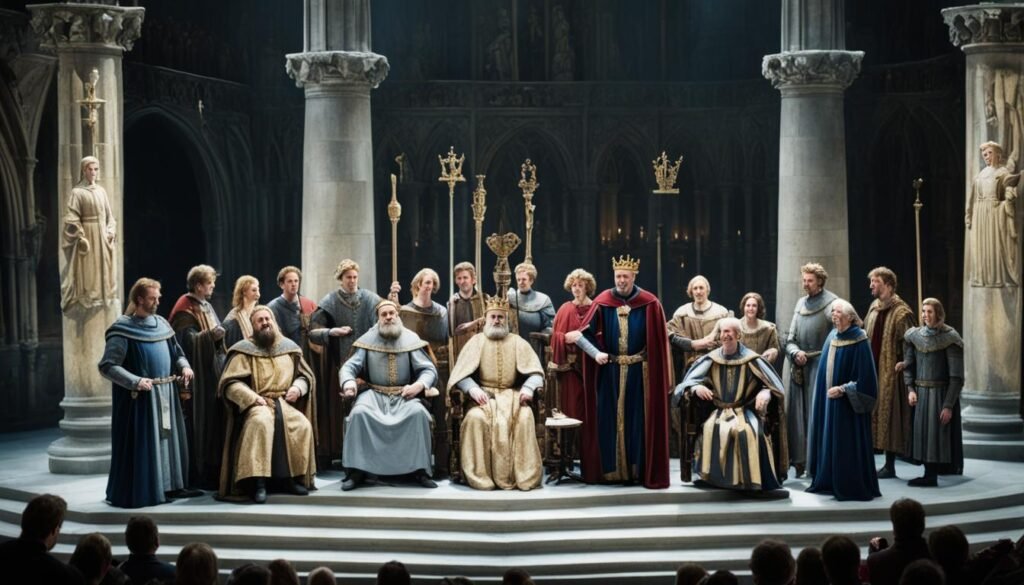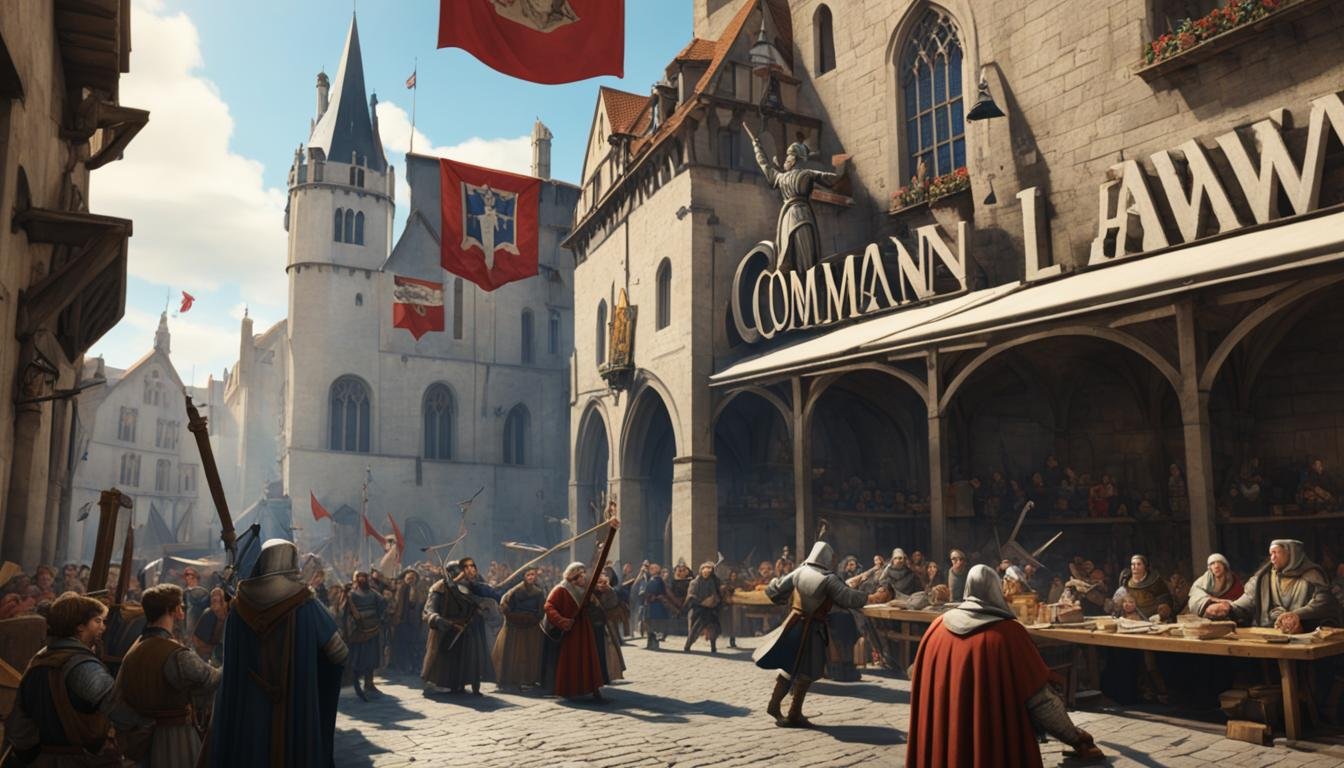Did you know English common law began in the early Middle Ages? It was established in the 11th century near London at the King’s Court.
The origin of common law is connected to England’s history and the Norman Conquest of 1066. Before the Normans came, the legal systems were like those of other Germanic peoples. But the Normans spoke French and brought their own laws.
Early common law was about rules to follow in court. But it changed to highlight people’s rights. Until the late 19th century, judges shaped the law more than lawmakers. They did this by setting legal examples, known as judicial precedents.
Key Takeaways
- The English common law originated in the 11th century King’s Court (Curia Regis) near London.
- The Norman Conquest of 1066 significantly influenced the development of the common law in England.
- Until the late 19th century, English common law was primarily developed by judges rather than legislators.
- The common law evolved from a focus on procedural remedies to one emphasizing substantive rights.
- Judicial precedents and stare decisis (the doctrine of precedent) are crucial in the common law tradition.
Henry II and the Establishment of Royal Courts
The 12th century brought big changes to us in northwestern Europe. Local, informal laws were replaced by organized government rules. This shift was greatly pushed by King Henry II of England (1154-1189). His time saw the start of the Exchequer and the Courts of the King’s Bench and of Common Pleas in Westminster. Before this, the king’s court moved around with him, meeting where he was.
The Creation of Permanent Institutions
Henry II made significant changes to how royal justice worked. He made the king’s court available all over the land, from the smallest towns to the largest cities. This included everyone from common folks to the top nobles, opening up the monarch’s legal system.
Freemen and the Decline of Feudalism
Henry II’s reign marked a big shift toward common law and away from feudalism in England. More people, especially freemen, started taking part in the legal system. By doing this, Henry II played a key role in setting up the basis for the legal system we know today.
“Henry II is known as the ‘Father of the Common Law’ for his revolutionary judicial innovations in England, which established a new judicial system where process was as vital as outcomes.”
One of his ideas, the Writ of Right, helped make sure everyone was treated fairly, without taking power away from the local lords. This strategy kept the peace. It also helped the legal tradition of precedents and stare decisis grow strong.

The start of these permanent legal organizations marked the end of feudal times under Henry II. This also began the use of uncodified law that later became the backbone of common law in England. Gradually, this shaped the common law we still see in England today.
The origin of common law and Its Procedural Innovations
Common law started in the late 12th century. Then, a royal justice system under King Henry II grew. It wasn’t about making big changes in laws. Instead, it took many practices about crime, family, property, and inheritance and made a single, big system. This new system stood out in the way it dealt with things, especially in its procedures.
Common Law as Customary or Case Law
The Common Law system used written documents a lot. It focused on the king’s ‘writs’ and solving arguments with the help of local people in juries. This way, both the law and the facts could be found. And it made a clear order for how courts should work.
As we moved away from feudalism, more people became freemen. Thanks to new rules about property law, called Writ of Mort d’Ancestor and Writ of Novel Disseisin, freemen could now sue others. This changed who had power and started the way for our property rights today.
The Common Law’s new procedures and the bigger Royal Courts made local lords less powerful. Then, King Edward I made some key changes during his rule. He said all criminal cases must have a jury, and he let people ask for payment if they were wronged.
In the 14th century, the beginning of law of equity, or conscience, next to common law, popped up. It had its own court, the Court of Chancery, which decided cases fairly, even without clear rules. This court looked at cases involving fraud, trust break, paying twice, and keeping property unfairly.
During King Edward I’s time, the title of lawyer started to become official. The Four Inns of Court in London were the places to go for this. Plus, the Year Books started in the 16th century. They were where lawyers found old cases to use in new arguments.
The 15th-century Wars of the Roses made a mess. New courts outside the common-law system, like the Court of Star Chamber and the Court of Requests, were set up. But, common law’s main ideas still shaped the legal systems we see in England and America today.

Contrasting Civil Law and Common Law Traditions
The world’s legal systems are mainly divided into two traditions: civil law and common law. These approaches have influenced legal systems globally, including how courts make decisions and how laws are written.
The common law tradition started in England during the Middle Ages. It later spread to British colonies like the United States, Canada, Australia, and India. This system uses court decisions from the past to guide future ones. It’s known for being flexible and not written down in a single book. This allows judges to change and adapt laws for new situations.
On the other hand, the civil law tradition began in continental Europe. It then spread to areas controlled by Spain, Portugal, and France. Civil law has detailed legal codes with specific rules and processes. In these systems, judges mainly apply the law instead of making new laws.
| Civil Law | Common Law |
|---|---|
| Codified legal system based on comprehensive codes | Uncodified system based on judicial precedents |
| Judges have a more limited role in interpreting the law | Judges play a crucial role in shaping the law through their rulings |
| Originated from Roman law and influenced by legal scholars | Emerged from the English monarchy and the system of royal courts |
| Prevalent in countries like France, Germany, and Japan | Predominant in the United States, United Kingdom, and former British colonies |
Choosing between civil law and common law greatly affects how a country’s legal system works. Civil law heavily relies on written laws, while common law builds on judges’ decisions over time. This key difference affects how laws are understood, applied, and resolved in court.
Knowing where civil law and common law come from and their key points is crucial in today’s legal and business world. It’s important for lawyers, business people, and anyone curious about the legal system to understand these two different traditions. This understanding offers critical insights into the array of legal systems around the globe.
“The common law is not a brooding omnipresence in the sky, but the articulate voice of some sovereign or quasi-sovereign that can be identified.” – Oliver Wendell Holmes Jr.
Conclusion
In England, common law and on the continent civil law developed. They’ve created two main legal systems influencing global law. Common law is shaped by judicial precedents and stories of previous cases. But civil law is based on detailed legal codes and laws passed by the government. This causes big differences in how judges decide cases, the way they think about the law, and their methods to interpret it.
Knowing about the start and growth of these legal systems is needed in today’s complex legal world. Both in the United States and all over the world. The English common law, starting from the times of Anglo-Saxon kings and influenced by Roman law, is everywhere today. It came about through colonialism, spreading its influence. The idea of stare decisis, where judges look at past cases to decide, is key in common law. This is different from civil law, which relies more on written codes and laws.
Whether you’re working in the law field, studying it, or just interested, understanding these different legal systems is crucial. It helps you get a better grip on the Anglo-American legal system and how it affects laws globally. This background is key to making sense of how law is made, interpreted, and how it affects society. Having this knowledge is very important in an ever-changing legal world. It’s also vital for ensuring laws are just and fair for everyone.
FAQ
What is the origin of the common law tradition?
How did the reign of Henry II contribute to the development of the common law?
What were the key innovations of the common law tradition?
How does the common law tradition differ from the civil law tradition?
Source Links
- https://www.britannica.com/topic/common-law
- https://users.ssc.wisc.edu/~rkeyser/?page_id=625
- https://en.wikipedia.org/wiki/Common_law
- https://digitalcommons.lasalle.edu/cgi/viewcontent.cgi?article=1179&context=the_histories
- https://www.tba.org/index.cfm?pg=LawBlog&blAction=showEntry&blogEntry=26853
- https://lawschoolheretic.com/2015/12/21/henry-ii-of-england-founder-of-u-s-common-law/
- https://wisc.pb.unizin.org/ls261/chapter/ch-2-1-the-origins-of-common-law/
- https://www.britannica.com/topic/common-law/Early-statute-law
- https://academic.oup.com/book/39379/chapter/339055190
- https://www.law.berkeley.edu/wp-content/uploads/2017/11/CommonLawCivilLawTraditions.pdf
- https://www.diffen.com/difference/Civil_Law_vs_Common_Law
- https://www.investopedia.com/terms/c/common-law.asp
- https://study.com/learn/lesson/what-is-english-common-law.html
- https://scholar.harvard.edu/files/shleifer/files/legal_origins.pdf

